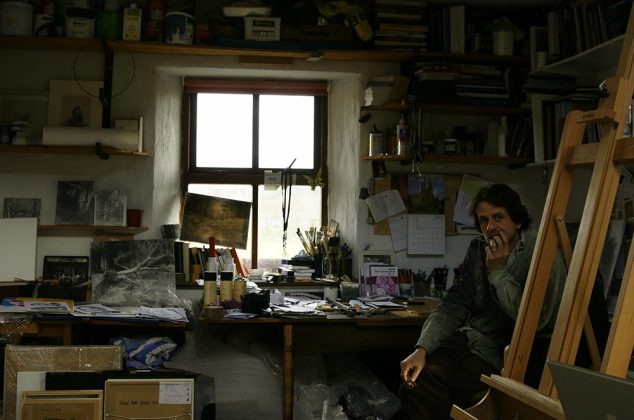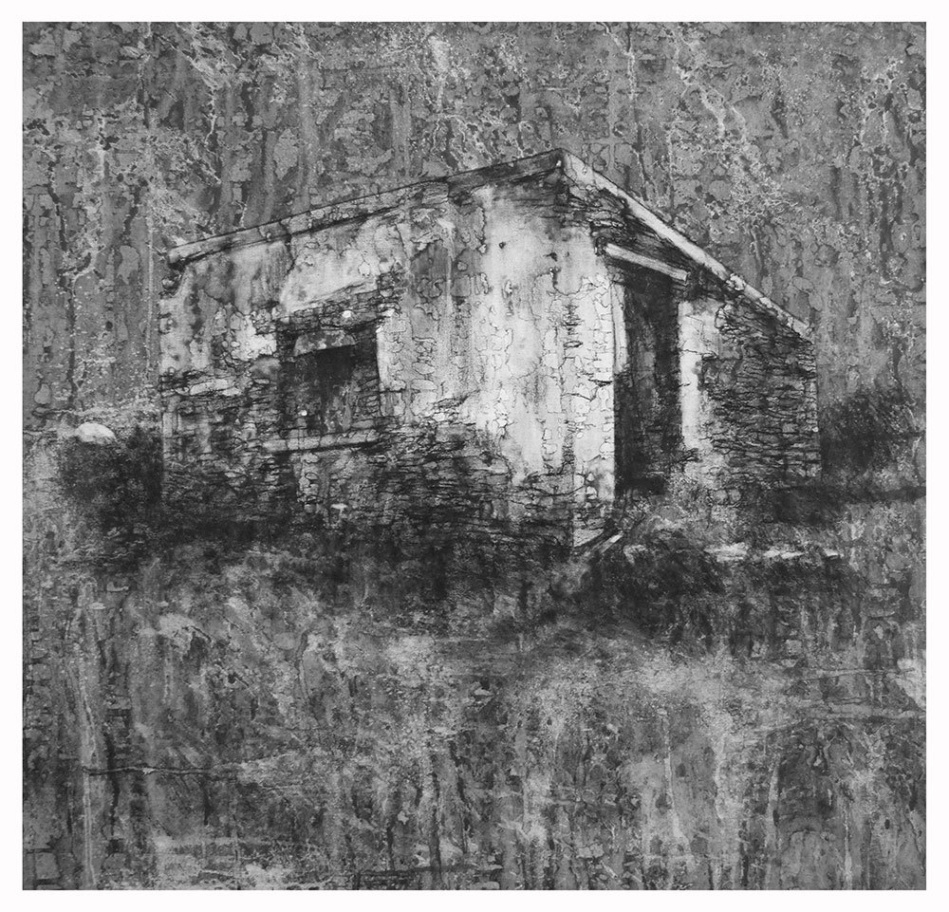Meet the Artist - Michael Wann

Wann’s work is specifically drawing-based, and juxtaposes arbitrary or transient images of cleared landscape, with more thought provoking depictions of the dereliction of habitation. The work is as much about a process of mark-making as it is about representing a seemingly neglected landscape.
Born in Dublin in 1969, Wann lives and works in Co. Sligo. He has held solo exhibitions at the Linenhall Arts Centre, Castlebar (2005), the Ashford Gallery at the RHA (2009), and Sligo Art Gallery (1999, 2002, 2005, 2009), where he won an Iontas Drawing Award in 2000. He has been awarded residencies at the Cill Riallaig Project, Co. Kerry (2001, 2004, 2008, 2010), and fellowships at the Ballinglen Arts Foundation in North Mayo (2007, 2008). He has been selected for the RHA’s Annual Exhibition since 2004, where in 2006 he was awarded the AXA Insurance Drawing Prize. In 2010 Hughie O’Donoghue selected Michael’s work for both the Tom Caldwell Drawing Prize and the Rowel Friers Perpetual Trophy at the Royal Ulster Academy’s 129th Annual show.
“Michael Wann’s fragile ephemeral images of derelict buildings depict a rare transient quality which is both harrowing and beautiful, evoking themes of memory, neglect and loss. Despite, or because of his expert skill as a draughtsman, it is within the versatility of the medium (charcoal and water on fine grain canvas) that there exists a delicate balance, between an imperfection of process and an exacting act of observation, adding a poignant vulnerability to this new body of work.”
Clea van der Grijn
Q: Tell us a little about yourself, your background, where you’re from and where you live?
I’m from Dublin originally. I came to Sligo in 1987 to do a one-year cert. in art and design, and pretty much never left. Sligo’s dramatic landscape caught hold of me straight away, and thoughts of returning to city life dwindled. I completed a Diploma in Fine Art at the then Sligo RTC’s art department. Sean McSweeney was our painting lecturer, and in retrospect I realise it was he who introduced me to the notion of the importance of a ‘sense of place’. He spoke of the landscape in a way I hadn’t heard before. I live in north Sligo, on the edge of Lissadell estate. It’s a place I miss when I’m away from it, and coming home is almost always a relief.
Q: When you were small, what did you want to be when you grew up? Were there any clues in your childhood that you would follow an artistic path later?
I’m told I always scribbled and drew as a child, though I have little recollection of it. As a teenager at school art was an automatic choice and I don’t remember ever wanting to do anything else.
Q: How long have you been an artist and why choose an arty profession over a more conventional career, like being an accountant, or working in an office for instance?
When I left college in 1992 I had no notion of what to do and knew little about being a professional working artist. The diploma I did was great for making you love the smell of oil paint or teaching you how to make a stretcher, but in terms of information or support in how to be an artist it was pretty crap. I didn’t want to study further as that would have meant city life somewhere. I worked on a shellfish farm for ten years and made drawings on the kitchen table by night. I’ve always felt that ‘drawing’ chose me, rather than me it.
Q: When did you create your first work and what was your subject matter?
My first work?!? Jeepers…I made a series of paintings for my diploma which were loosely concerned with the relatively murky issues surrounding my being adopted. I suppose I’d consider that as my first venture into making ‘real’ work, though needless to say it was studenty and indulgent…
Q: Has your style changed over the years and what might have influenced this change if yes?
I’ve been working in black and white for twenty years now, with occasional forays into colour. But I’m always drawn back to monochrome. As an artist you cant help but be influenced by other work that you see, and these influences can be subtle or direct, but also can be very slow to emerge in your own work. I remember seeing Leonardo’s Virgin and Child in the National Gallery in London as a teenager and being blown away by it. And strangely enough it remains a must see on occasional trips there. Some days in the studio I’m working on very detailed things, spending hours or days getting detail right, then the next day I might be hopelessly pushing charcoal around a massive piece of paper, and generally making a big grey mess. It depends

Image: Michael Wann, No Ghosts 1, charcoal & wash on canvas
Q: Have you ever tried other art forms like photography, sculpting, making music, or dancing for instance?
I take an awful lot of photos for my work, but always regard this as a backup to the main event of drawing. I sometimes think I’d like to do some sculpture, and certainly printmaking holds a fascination.
Q: What other artists or people have influenced or inspired you, and in what ways?
There’s too many to mention really. Let’s see…when you see work in the flesh it makes a huge difference, so seeing Picasso’s ‘Gurnica’ in Madrid was an unforgettable experience. I never really ‘got’ Matisse while in college, but seeing some of them in New York changed that. I love the work of Jean Baptiste Corot, but really, there are too many artists both long dead and contemporary that I admire... In terms of contemporary Irish work, I remember being blown away by Diarmuid Delargy’s prints, so influenced by Rembrandt’s etching, Picasso’s too, but so very much their own. I’m also as influenced by poetry and fiction, Cormac McCarthy being a major influence on my thinking about landscape and the representation of it.

Image: Michael Wann, No Ghosts 3, charcoal & wash on canvas
Q: What is the thing you most enjoy about your work?
Very occasionally a piece of work will breath or sing all on its own, either during the making of it, or rarer again, long after completion. Often when you’re right in the middle of it it’s the most rewarding time, lost to all the flotsam of daily life and absorbed fully in the mark-making process. That place where everything tastes of charcoal and your arm and brain buzz from the repeated discovery of all the types of marks you can make, rational and intentional, or spontaneous, accidental and random. Stopping, knowing when a thing is done is as important as anything; I’m guilty continually of over-working a drawing and watching it die right there before me.
Q: How do you keep motivated if you’re having a bad day?
Just keep working generally. Work through the frustration or failure. Or just go home, focus on life’s other surprises; there’s nothing like daily life to make you realise your work isn’t half as special as you sometimes think, and going back into the studio next day I often feel this; which of course just makes you push harder towards making it better…
Q: How have you handled the business side of being an artist, promoting yourself and getting exposure, selling your work etc? How has the recession impacted on your livelihood?
It’s gotten easier as my work has become a little better known. And I’ve become more confident about talking about my work, which is an essential part of being an artist but also an understandably difficult thing for many artists. The recession has impacted on the arts across the board and in terrible ways. I made a living from my work for many years. That’s gone now; I’ve seen my entire salary wiped out almost overnight. It’s a hard hard time for all. Somehow though, being in the studio and working hard has never really been about money. It’s always rewarding to sell work of course, but in the making of it, the notion of sale mustn’t be a feature. If it does, in my experience, there’s more chance that the work is failing, or isn’t as true as it might be.
Q: Could you tell us a little more about your exhibition in Draíocht’s Ground Floor Gallery ‘Derelict’? Do you go looking for specific derelict buildings, and if yes, how do you choose which ones to draw?
Most of my work is about the notion of neglect or abandonment, within a landscape-based context. There are personal themes underlying the work of course. ‘Derelict’ as a body of work, evolved from time spent on residency at the Ballinglen Foundation in Ballycastle Co. Mayo and at the Cill Rialig artists’ retreat in Ballinskelligs Co. Kerry a number of years ago. I had been aware for a number of years that my birth father had died in Kerry, and having never met him, felt an odd kind of draw to the county. And so choosing abandoned dwellings as a reference point seemed like a way of somehow striving to make a vague connection, or to articulate a sense of loss or regret for things past…

Image: Michael Wann, The Past is Stone, charcoal on canvas
Q: When I look at your work, I’m immediately drawn towards the houses that remind me of my grandparent’s house. Do people often tell you about their memories of certain buildings, jolted perhaps by looking at your work?
People react differently to some of my work. There is a natural nostalgia in many of us I think. I’m not necessarily that interested in nostalgia per se, not where the derelict buildings are concerned; as I said before, its more to do with articulating or understanding a sense of loss, whether it be deeply personal, or just about changing times and the natural cycle of the crumble and decay of habitation.
Q: You have two more exhibitions coming up this year, can you tell us a little bit about them?
I’m showing at the Cross Gallery in Dublin in July of this year, with an exhibition called ‘we seek another place to rest’. It’s a show of small and large-scale drawings of piles of sticks and other features of neglect. In some ways it’s a much more personal show than ‘Derelict’, at least that’s how it feels, as it charts in an indirect way more profound issues of trauma and loss. But of course folk can just see it as drawings of sticks if they want… Then I’ve a show with Droichead Arts Centre in August entitled ‘Sticks and Stones’. Can you guess what that one’s about?!?
Q: Do you have any advice you could give to an artist just starting out?
Study law………only joking. Dunno really, what ever you’re making that it be the best it can be, in terms of technique or facility of medium. I was never any good when I started out at promoting myself, and it’s a vital part of the art world, to either be able to do it yourself or better again have a gallery do it for you.
Q: Where do you see yourself in 10 years?
Making work.
Q: What are your interests and hobbies outside of drawing?
Music, books, walking, the inexplicable ‘looking’ at landscape, boating on the Shannon, my family, all that stuff…


